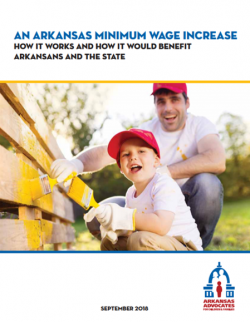
About one in four Arkansas workers – almost 300,000 people – would benefit from the minimum wage increase on the ballot in November, according to a new report released today by Arkansas Advocates for Children and Families.
The proposal, which will be decided by Arkansas voters on Nov. 6th, would gradually increase the Arkansas hourly minimum wage level of $8.50 to $11 by 2021.
Most of the workers who would benefit work full-time (57 percent), are over 20 years old (85 percent) and are women (60 percent), according to the report. They include 213,000 whose pay would be directly increased by the new law and another 88,000 workers who make slightly more than the state minimum wage whose pay would likely rise as employers pay more to keep them.
By 2021, the average cumulative increase in annual pay for the 300,000 workers directly and indirectly impacted by the proposal would be $1,520.
The minimum wage increase would help improve the financial stability of tens of thousands of Arkansas families earning low wages who are still struggling to make ends meet despite the growing economy and low unemployment. Many are parents who are the sole breadwinners in their households.
“The increase would be a great first step in reducing our state’s high child poverty rate and giving children a better start in life,” said Rich Huddleston, AACF executive director.
Nearly 155,000 Arkansas children will have at least one parent whose income will increase by the minimum wage boast to $11 an hour. Parents would comprise 27 percent of the workers impacted by the minimum wage increase. According to new data from the Census Bureau, 22.5 percent of Arkansas children live in families with incomes below the poverty line.
“Every voter knows someone who will benefit from the minimum wage increase, whether it’s an immediate family member, a relative, a neighbor, or a friend,” said Huddleston. “Despite the positive impacts the minimum wage increase would have on the lives of our children and families, I have no doubt that those who oppose it will try to misrepresent who will benefit from the increase, but the data in this study about who benefits is clear.”
According to the report, the total cumulative increase in wages to low-income workers by 2021 will be over $455 million. Because the wages will go to low-income employees, the dollars will be more likely to be spent locally, boosting local economies as a whole.
Read and download the full report here.
